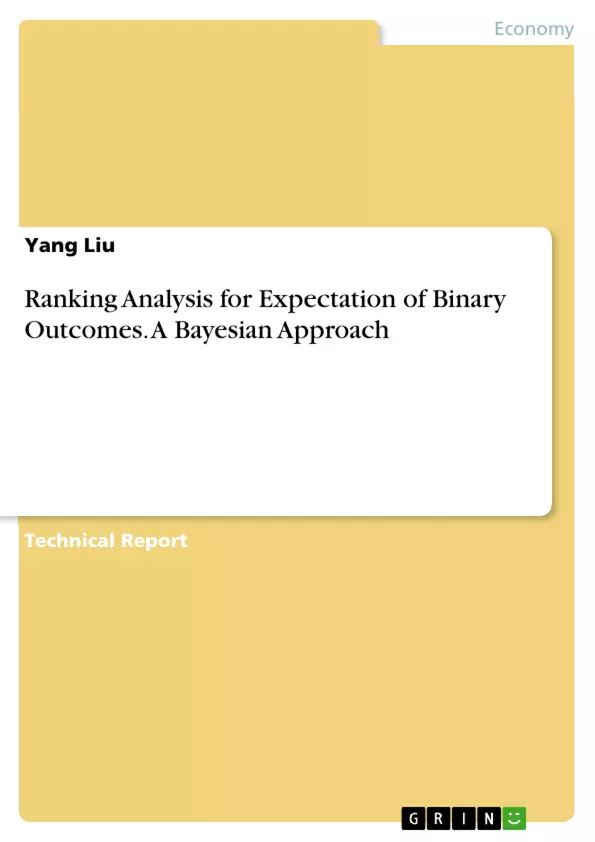The estimation and grading of customer Probability of Default (PD) using a firm-wide master scale for internal portfolios is a well established procedure in many financial institutions. However, there are often discussions within the institutions about the comparison between the grade PDs, the portfolio average PD calculated across grades and the observed Default Rate (DR). The Bayesian estimator for the grade PD based on different prior distribution assumption is often referred to as an alternative over the simple default rate.
In this paper, we apply and compare the approaches to derive the posterior distribution of grade PDs that is closely linked to the portfolio performance assumptions made according to the Master Scale. We then detail the numerical analysis of both informed and uninformed Bayesian estimators for the Grade PDs with simulated single and multi-period data sets. We compare the results in term of prior and posterior Density-in-Range (DiR) and Direction-of-Movement (DoM) for each Grade. With data analysis and preference of criteria, the approach and metrics can be used for both model development and validation, or other risk-awareness reporting and information update exercises to help understand the difference between expectation and observed data.
More importantly, this approach provides a methodology to quantify such differences according to knowledge and understanding of the observer, which was not possible for simple approaches such as direct numerical comparison of Master Scale defined PD and the simple rate.
Inhaltsverzeichnis (Table of Contents)
- Abstract
- Introduction
- Probability Distributions of the Initial Beliefs
- Uninformed Uniform Prior Distribution
- Pre-calibrated Prior Distribution
- Probability Distributions with Observed Data
- Posterior Distribution from Un-informed Prior
- Posterior Distribution from Informed Beta Prior
- Probability Distributions with Multi-period Observations
- Through-The-Cycle Posterior Distributions from Un-informed Prior
- Through-The-Cycle Posterior Distributions from Informed Beta Prior
- Conclusion
Zielsetzung und Themenschwerpunkte (Objectives and Key Themes)
This paper aims to investigate the estimation and grading of customer Probability of Default (PD) using a firm-wide master scale for internal portfolios, focusing on the comparison between the grade PDs, the portfolio average PD, and the observed Default Rate (DR). It explores the Bayesian estimator for the grade PD based on different prior distribution assumptions as an alternative to the simple default rate. The study analyzes numerical simulations of both informed and uninformed Bayesian estimators for the Grade PDs with single and multi-period data sets.
- Estimation and grading of customer Probability of Default (PD) using a firm-wide master scale.
- Comparison between grade PDs, portfolio average PD, and observed Default Rate (DR).
- Analysis of the Bayesian estimator for the grade PD based on different prior distribution assumptions.
- Numerical simulations of informed and uninformed Bayesian estimators for the Grade PDs.
- Evaluation of the results in terms of prior and posterior Density-in-Range (DiR) and Direction-of-Movement (DoM) for each Grade.
Zusammenfassung der Kapitel (Chapter Summaries)
The paper begins by introducing the concept of a Probability of Default Master Scale and its application in financial institutions. It then delves into the probability distributions of initial beliefs, exploring both uninformed uniform prior distributions and pre-calibrated prior distributions. The paper further examines probability distributions with observed data, analyzing the posterior distribution from both uninformed and informed prior assumptions. Finally, it discusses probability distributions with multi-period observations, including through-the-cycle posterior distributions from both uninformed and informed prior assumptions.
Schlüsselwörter (Keywords)
The core concepts and terms explored in this paper include Portfolio Default Rate, PD Master Scale, Grade Mean PD, Bayesian PD Estimate, Posterior Density in Range, and Posterior Direction of Movement.
- Quote paper
- Yang Liu (Author), 2017, Ranking Analysis for Expectation of Binary Outcomes. A Bayesian Approach, Munich, GRIN Verlag, https://www.grin.com/document/367170



